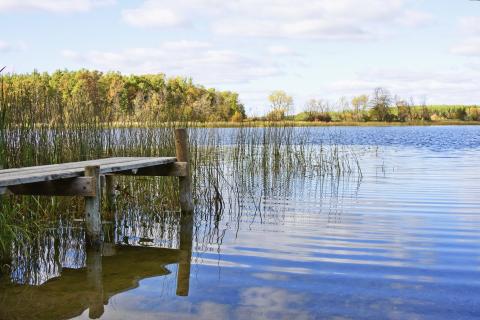
Lake health corresponds to ecoregions and the differences in geography, soils, climate, lake depth, and size of the lake's watershed, as well as land use and alterations. Lakes in the northeast are generally healthy, with conditions worsening as you move south and west. In the parts of the state with the most cultivated land or urbanization, lakes are less likely to meet water quality standards meant to protect aquatic life and recreation uses.
Overall conditions
The MPCA and partners have monitored lakes in all 80 of Minnesota’s major watersheds. Based on the data, they determined whether the lakes studied meet the water quality standard for recreation like swimming and wading.
- statewide, 75% of lakes meet water quality standards; 25% of lakes don't meet water quality standards due to high levels of phosphorus and algae
- in the last two decades, overall lake quality trends have stabilized — the vast majority of lakes’ water quality measures have stayed about the same
- the water quality of lakes in Minnesota is similar to lakes in our region and generally better than lakes nationwide
- phosphorus is the contaminant of greatest concern in Minnesota lakes
- chloride in lakes from road salt — in urban areas and near roads — is increasing and is especially troubling, because it stays in the water indefinitely
Current regulations and voluntary best management practices will not be sufficient to maintain healthy lakes and shield impaired ones from additional pollution. Even if all existing laws were followed to the letter, lakes would still be subject to unacceptable levels of nutrients and other contaminants. Targeted action will be required to cut off unregulated sources of pollution.
North-northeastern region and the Arrowhead
- Good health: After being heavily logged historically, this region is now dominated by forest (41% of the land) and water and wetlands (more than 48%), which limits sediment and nutrient runoff.
- Meets standards: In the watersheds the MPCA has fully assessed in the region, 95% of the lakes meet water quality standards for aquatic recreation.
Central region and metro area
- Land use threats: This area combines characteristics of both the northeastern and southern regions. Shallow lakes here that are in highly urbanized or heavily farmed watersheds typically have poor water quality. Deeper lakes, or those in watersheds with less urbanization or agricultural land use, generally have better water quality.
- Half are impaired: In the watersheds the MPCA has fully assessed in the region, 54% of the lakes meet water quality standards for aquatic recreation.
Southern and western Minnesota
- Poor health: Much of this region’s prairie has been converted to agricultural uses (78% is cropland), while wetlands have been drained and the installation of artificial drainage has increased. This has caused high nutrient and sediment levels in the region’s naturally shallow lakes.
- Most impaired: In the watersheds the MPCA has fully assessed in the region, only 14% of the lakes meet water quality standards for aquatic recreation.
Representative lakes
- Northeastern region: Ten Mile Lake near Hackensack is among the largest and deepest lakes in Minnesota, and is in a watershed dominated by forest. Development pressure is light. Water quality is excellent. The lake is being monitored to track its response to a recent zebra mussel infestation.
- Central region: Medicine Lake in Plymouth is in a watershed that is entirely developed, with the exception of a park on the north end of the basin. The lake has excess levels of phosphorus — which contribute to nuisance algal blooms in the summer — and high chloride concentrations, which can stress fish. It also has Eurasian milfoil, an invasive species.
- South and west region: Madison Lake in Blue Earth County is in a watershed dominated by agricultural land uses. It is also a popular lake for fishing and swimming in the area, with multiple public accesses and parks along the shore. Phosphorus levels are high, and algae blooms occur on the lake.